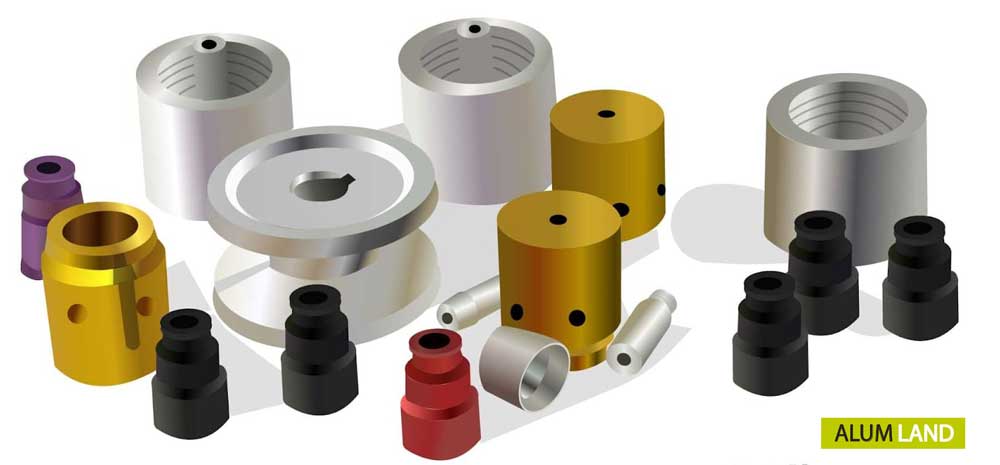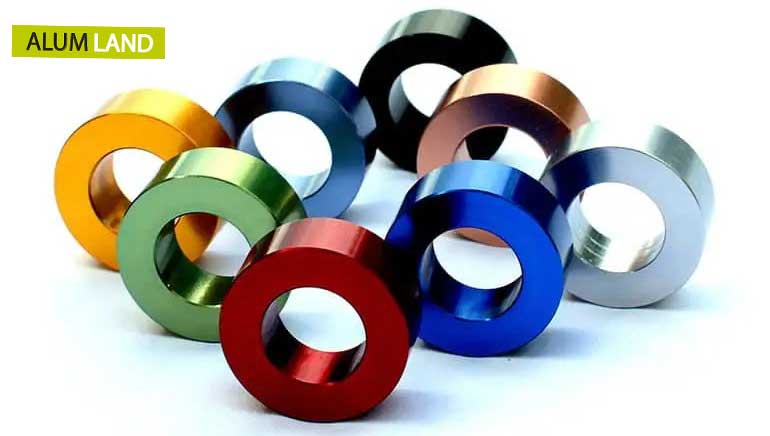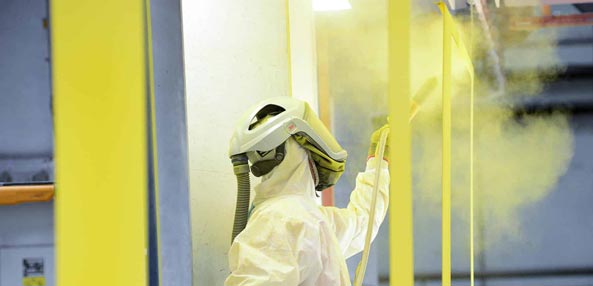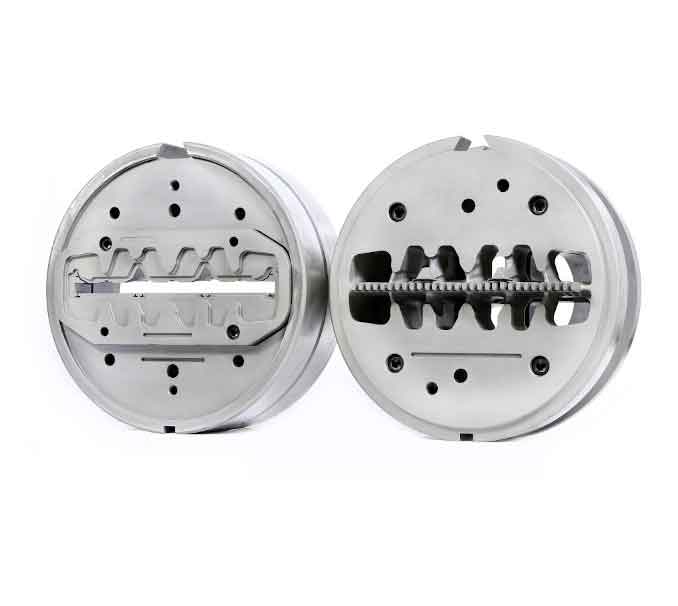What is Aluminum Anodizing
Anodizing is an electrochemical process in which a stable oxide layer is formed on the aluminum surface by means of an electric current. This natural oxide layer increases the resistance against corrosion and wear of the aluminum profile and allows the surface to be painted. In fact, unlike painting and other coating processes, the oxide layer has a stronger bond with the base aluminum and therefore has a stronger protective property. The use and application of this process in various industries is increasing.
Aluminum Anodizing Services
The aluminum anodizing services of AlumLand Industrial Complex include a range of processes and techniques that are used to improve the surface properties of aluminum in industrial applications. The range of aluminum anodizing services of Alum Land includes services before the anodizing process, various types of anodizing, and services after anodizing, which include:
Services before anodizing:
Polishing and brushing before anodizing
Before the anodizing process, the aluminum surface may need to be polished or brushed to achieve a uniform and smooth appearance. This makes the metal surface look more attractive and higher quality after anodizing. These services are usually used for decorative parts and building facades and luxury products and home appliances.
Cleaning and chemical surface preparation
To create a high-quality coating, the aluminum surface must be completely clean and free of any contamination, grease, or rust. This is usually done using chemical cleaners and special acids. Precise surface preparation guarantees the high quality of the anodizing process and the longevity of the final coating. These services are used for industrial machinery parts and sensitive electronic and telecommunication parts.
Aluminum anodizing
Performing all anodizing processes in AlumLand Industrial Complex includes type I (chromic), type II (sulfuric) and type III (hard anodizing) anodizing, and thick anodizing if needed.
Aluminum Anodizing Company
AlumLand Company, as one of the largest manufacturers and providers of anodizing services in Iran, using advanced equipment and experienced staff, provides all anodizing services in various thicknesses and colors.
Price inquiry : 09123794374
Aluminum post-anodizing services
Aluminum anodizing color
In Alum Land Industrial Complex, we use the best machines and high-quality paints in the coloring process. Coloring services include various methods of electrolytic coloring, coloring with organic paints, coloring with oxide paints. Each of these methods has its own characteristics and applications.
Precise control of coating thickness
One of the specialized services of Alum Land Company in the anodizing sector is the precise control of the anodizing coating thickness. Some industries need the oxide layer to be created to a specific thickness to optimize the performance of the part in special conditions. The need for these services in thickness is especially seen more in sensitive industries such as: aerospace and military industries and advanced electronic components.
Restoration and repair of anodized aluminum parts
In some cases, aluminum parts that have been previously anodized may need to be repaired or restored. These services include removing the previous anodized layer and re-performing the anodizing process. These services are performed to repair the following parts:
Parts of industrial machinery that have been worn out
Old and worn equipment that needs to be restored
AlumLand Company, in the restoration and repair of anodized aluminum parts and profiles, in addition to sufficient expertise and experience, uses up-to-date technology and modern machinery
Types of Aluminum Anodizing
The electrochemical process of aluminum anodizing is used to increase resistance against corrosion, wear, and environmental factors. The choice of method and type of aluminum anodizing depends on the type of application of the part and the need for special features such as thickness, color, etc. In the following, we will introduce the types of aluminum anodizing methods and the advantages and applications of each.
Anodizing with chromic acid (Type I anodizing)
Anodizing with chromic acid is the oldest method of anodizing, which uses chromic acid solution as an electrolyte. The aluminum oxide layer created on the surface of the part is very thin (usually between 0.5 and 2 microns) and therefore (due to its low thickness) this type of coating is used for use in environmental conditions with a medium degree of hardness.
Features:
Very thin and light layer
Medium degree of protection against corrosion
Suitable for sensitive and small parts
Applications:
Aerospace industries: Due to its light weight and corrosion resistance, it is used in parts such as wings and components of aircraft structures.
Sensitive electronic components: For parts that need more protection against corrosion without adding much thickness to the part.
Anodizing with sulfuric acid (Type II anodizing)
Anodizing with sulfuric acid is one of the most common and widely used anodizing methods. In this process, sulfuric acid solution is used as an electrolyte. The created aluminum oxide layer is thicker and more resistant compared to anodizing with chromic acid. The thickness of the oxide layer is usually between 5 and 25 microns. This method of anodizing is used for industrial and decorative applications.
Features:
Possibility of coloring the surface using different colors
High resistance to corrosion
Applications:
Automotive industry: Rims, handles, and interior and exterior parts
Home appliances and electronics: The body of laptops, mobile phones, and other electronic products that need a resistant and beautiful coating
Structures and architecture: Such as facades, windows, and other building components that need protection against weather conditions

After the anodizing process is finished, fine pores may be created on the surface of the aluminum profile or there may be a need to paint the part, which in the finishing stage, if necessary, the process can be applied separately or together on the part, which includes:
Anodizing coloring
One of the important features of industrial aluminum anodizing is the possibility of coloring the surface after the anodizing process. In this method, the colors penetrate into the pores of the oxide layer and create a permanent and resistant color. These colors are resistant to UV rays and corrosion. Coloring can be done in two ways: either by using organic colors or through the electrolytic method in which metal ions enter the oxide layer. Coloring after the anodizing process is used for:
Decorative parts
Construction industries and aluminum facades
Home appliances and electronics
Sealing
Sealing is used to increase corrosion resistance and the life of the coating after anodizing. In the sealing process, the part is immersed in hot water or steam to close the pores and stabilize the oxide layer. This increases the corrosion resistance and life of the part. The applications of this process include:
Electronic and moisture-sensitive parts
Food and pharmaceutical industries
Nickel-acetate sealing
In this method, after the anodizing process, a coating of nickel or acetate is used to improve the mechanical and chemical properties of the surface. This coating increases the resistance to corrosion and wear and is usually used in applications that require more durability.
Applications:
Oil and gas industries: In pipes and equipment that are exposed to chemical and corrosive materials.
Marine equipment: For parts that are in contact with salt water.

Aluminum Anodizing Services in Tehran
Price inquiry : 09123794374
Alum Land Industrial Complex is one of the most reputable companies providing anodizing services. In addition to producing aluminum products, it offers all anodizing services with high quality and To place an order or inquire about prices, please contact the sales experts of Alum Land Industrial Complex.competitive prices to its customers.









